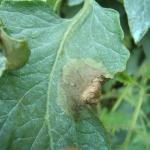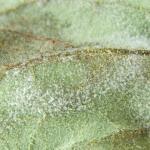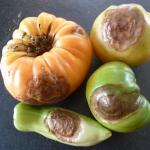Solanaceous, Late Blight
Phytophthora infestans
Late blight, caused by the fungal-like organism Phytopthora infestans, is the most severe disease of potato and tomato. The pathogen caused widespread starvation and immigration during the Irish potato famine in the 1840s. The pathogen spreads easily on wind and rain and is capable of destroying entire fields in a few days. Late blight is extremely destructive when not managed, quickly killing foliage and infecting fruit and tubers.
Identification:
The most common symptoms on tomatoes are sunken, dark green or brown lesions on leaves and brown lesions on stems, with white fungal growth developing under moist conditions. Classic symptoms are large (at least nickel-sized) olive-green to brown spots on leaves with slightly fuzzy white fungal growth on the underside when conditions have been humid (early morning or after rain). Sometimes the lesion border is yellow or has a water-soaked appearance. Brown to blackish lesions also develop on upper stems. Firm, brown spots develop on tomato fruit.
Not all 'leaf blights' of tomato and potato are late blight! Several common diseases of tomato and potato cause leaf symptoms that can easily be confused with late blight. These include Fulvia leaf mold, early blight, Septoria leaf spot, and bacterial diseases. For photos and descriptions see Recognizing Tomato Blights.
Life Cycle:
P. infestans in the Northeast survives in potato tubers saved from last year for seed and in cull piles or soil that did not freeze during the winter. The pathogen does not overwinter in tomato and is not seed-borne. In more southern regions, the pathogen produces long-lived sexual spores (Oospores) that survive in infected crop debris and the soil. Sporangia from these southern areas are spread long distances bywind and wind-driven rain. Clouds protect spores being dispersed in wind from the killing effect of ultraviolet radiation. Phytophthora infestans needs cool (below 77 F), wet weather. Hot, dry summers, like 2010 are not conducive to late blight development. An exception would be where plantings are located where fog occurs periodically. The late blight pathogen has recently undergone changes in Florida that affect disease occurrence there and in other eastern states. Diseased tomato plants in south Florida have survived cold periods in winter allowing the pathogen to persist. Late blight has also been active into the spring as late as May indicating an increased tolerance for warmer temperatures. This means a potential source of inoculum persists until crops are being produced north of Florida and a ‘green bridge’ exists for the pathogen to progress on until it reaches the northeast.
Crop Injury:
In 2009, a new genotype of late blight caused by Phytophthora infestans, US22, caused a disease epidemic throughout the Northeast. First reports of the pathogen were recorded in late June, the earliest incidence of widespread disease ever observed in our region. US22 was detected in tomato plants for sale in garden centers in numerous states by extension specialists. Late Blight has occurred in New England sporadically in recent years and different strains of the pathogen have been responsible: US11 (1994-1998), US8 (1992-2010), and US17 (1996-1997). These genotypes of the late blight organism differ in host aggressiveness and fungicide resistance. US22 is more virulent on tomato, while US8 is more aggressive on potato. Environmental conditions in June and July of 2009 were extremely conducive for disease development as the late blight organism is favored by cool and wet weather. In 2009, growers were required to make numerous fungicide applications of the best materials on a shortened schedule to harvest marketable fruit. 2010 was much warmer and drier and late blight epidemics did not develop although both US22 and US8 were observed in localized outbreaks.
Monitoring & Thresholds:
- Scout and monitor tomato and potato crops on a regular basis (daily if possible), especially wet areas and whenever wet weather occurs.
- Check local extension Newsletters or websites often for information about late blight occurrence. Monitor the late blight forecast model at http://uspest.org/risk/tom_pot_map and or weather forecasting models at http://newa.cornell.edu/. Forecast models are based on the length of periods of humidity of greater than 90% and the temperatures during these periods as well as rainfall. Severity values accumulate if environmental conditions are favorable for the late blight pathogen. Disease is predicted to occur 7-10 days after 18 severity values have accumulated.
- Confirm late blight diagnosis with extension specialists or crop consultants. Promptly inform neighbors growing susceptible crops so they can be informed and take action to protect their plants. Late blight is a community disease.
Cultural Controls & Prevention:
- Eliminate initial inoculum. The most likely source of late blight is infected tubers that survived the winter in cull piles or compost piles, tubers that were saved, or tubers that remained in the soil unfrozen and appear as volunteer potato plants. The late blight organism requires living tissue to survive; it does not survive in the soil or carried tomato seed.
- Select resistant varieties were available. ‘Mountain Magic’, ‘Legend’, and ‘Plum Regal’ have excellent resistance to Late Blight. ‘Red Pearl’ and ‘Matt’s Wild Cherry’ are small fruited tomatoes with good resistance. Some heirloom tomato varieties have good tolerance to late blight. A few cultivars also have resistance to Early Blight (Alternaria solani, A. tomatophila) and should be considered. The development of triple (LB, EB, Septoria leaf spot) resistant varieties is underway at Cornell and other Universities.
- Start with disease-free tomato transplants.
- Scout your potato and tomato fields multiple times per week (daily if possible), focusing on low-lying areas, shady field edges, areas prone to morning fog, wet areas next to streams, ponds, or near overhead irrigation rigs, west facing slopes, or any area that is protected from the drying effects of wind and sun.
- Rotate tomato fields with non-solanaceous crops. Crop rotation is for the early blight and Septoria leaf spot diseases which are an annual problem, not late blight.
- Control potato and tomato volunteer plants as well as solanaceous weeds such as hairy nightshade, jimson weed, golden henbane, and others. The ornamental plants petunia and calibrachoa are also hosts for late blight; grow ornamental bedding plants and vegetable transplants in separate greenhouses.
- When late blight is found in small, localized areas, promptly destroy all symptomatic plants plus a border of healthy appearing plants to prevent disease spread. Pull up affected plants, kill them with a herbicide, or disk them under. When physically destroying plants, a fungicide application can prevent equipment contamination and release of spores into the environment. Pressure wash disking equipment after operation.
- Rogue out plants by cutting trellising, cutting the base of stems or uprooting the plant. There are several options for this:
- Cut strings, remove stakes, mow thoroughly, pull plastic, and incorporate residue
- Use herbicide to kill the crop
- Pile residue and cover with a tarp or large sheet of plastic to prevent further spread of spores and kill the tissue.
- Cut the stem or pull plants, allowing the crop to desiccate in the sun, as strong sunlight will kill spores released into the air.
- Apply late blight specific fungicides in affected fields and nearby fields on a regular basis according to a disease forecast model (Blight Cast) until tomato harvest is complete. Shorten spray interval when disease pressure is high or environmental conditions remain favorable for the late blight pathogen (cool and wet).
- Alternate fungicide applications among different chemical classes as indicated by FRAC code. Include a contact (protectant) fungicide in each application (chlorothalonil, mancozeb, or copper). Addition of a protectant fungicide enhances resistance management and fungicide effectiveness; it is often specified on the label and thus is a requirement. A fungicide with protectant fungicides alone becomes challenging when plants are actively growing as new growth is rapidly left unprotected.
- Good fungicide coverage is necessary. Work in affected fields last and clean equipment between fields.
- Disk under the field or kill with herbicide after harvest is complete.
Chemical Controls & Pesticides:
For Current information on disease recommendations ins specific crops including information on chemical control & pesticide management, please visit the appropriate crop section in the New England Vegetable Management Guide website.
http://nevegetable.org/crops/potato
http://nevegetable.org/crops/tomato-outdoor
Crops that are affected by this disease:
The Center for Agriculture, Food and the Environment and UMass Extension are equal opportunity providers and employers, United States Department of Agriculture cooperating. Contact your local Extension office for information on disability accommodations. Contact the State Center Director’s Office if you have concerns related to discrimination, 413-545-4800 or see ag.umass.edu/civil-rights-information.



